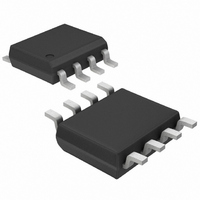MAX750AESA+ Maxim Integrated Products, MAX750AESA+ Datasheet - Page 7

MAX750AESA+
Manufacturer Part Number
MAX750AESA+
Description
IC REG PWM ADJ 8-SOIC
Manufacturer
Maxim Integrated Products
Type
Step-Down (Buck), PWM - Current Moder
Datasheet
1.MAX750ACSA.pdf
(16 pages)
Specifications of MAX750AESA+
Internal Switch(s)
Yes
Synchronous Rectifier
No
Number Of Outputs
1
Voltage - Output
1.25 ~ 11 V
Current - Output
450mA
Frequency - Switching
170kHz
Voltage - Input
4 ~ 11 V
Operating Temperature
-40°C ~ 85°C
Mounting Type
Surface Mount
Package / Case
8-SOIC (3.9mm Width)
Voltage - Supply
4 V ~ 11 V
Frequency-max
210kHz
Duty Cycle
92%
Pwm Type
Current Mode
Buck
Yes
Boost
No
Flyback
No
Inverting
No
Doubler
No
Divider
No
Cuk
No
Isolated
No
Lead Free Status / RoHS Status
Lead free / RoHS Compliant
*16-Pin Wide SO: All pins with the same name must be connected together externally.
The MAX750A/MAX758A switch-mode regulators use a
current-mode pulse-width-modulation (PWM) control
system coupled with a simple step-down (buck) regula-
tor topography. Input voltages range from 4V to 11V for
the MAX750A, and from 4V to 16V for the MAX758A.
The current-mode PWM architecture provides cycle-by-
cycle current limiting, improved load transient response
characteristics, and simpler outer-loop design.
The controller consists of two feedback loops: an inner
(current) loop that monitors the switch current via the
current-sense resistor and amplifier, and an outer (volt-
age) loop that monitors the output voltage through the
error amplifier (Figure 1). The inner loop performs
cycle-by-cycle current limiting, truncating the power-
transistor on-time when the switch current reaches a
predetermined threshold. This threshold is determined
by the outer loop. For example, a sagging output volt-
age produces an error signal that raises the threshold,
allowing the circuit to store and transfer more energy
during each cycle.
______________________________________________________________Pin Description
_______________Detailed Description
DIP/SO
8-PIN
1
2
3
4
5
6
7
8
–
PIN
WIDE SO
12, 13, 14
1, 15, 16
16-PIN
10, 11
4, 5, 6
2
3
7
8
9
_______________________________________________________________________________________
NAME
SHDN
GND
N.C.
REF
CC
I.C.
V+
SS
LX
Shutdown—active low. Ground to power-down chip, tie to V+ for normal operation.
Output voltage falls to 0V when SHDN is low.
Reference Voltage Output (+1.22V) supplies up to 100µA for external loads. Bypass to
GND with a capacitor that does not exceed 0.047µF.
Soft-Start. Capacitor between SS and GND provides soft-start and short-circuit protec-
tion. 510kΩ resistor from SS to SHDN provides current boost.
External voltage divider feedback point. When an external voltage divider is connected from
the output voltage to CC and GND, this pin becomes the feedback input for adjusting the
output voltage. Connect a 330pF compensation capacitor between the output and CC.
Internal Connection. Make no external connection to this pin.
Ground*
Drain of internal P-channel power MOSFET*
Supply Voltage Input. Bypass to GND with 1.0µF ceramic and large-value electrolytic capaci-
tors in parallel. The 1µF capacitor must be as close to the V+ and GND pins are possible.*
No Connect—not internally connected.
Current-Mode PWM Regulators
Adjustable, Step-Down,
Figures 1 and 2 show a capacitor and a resistor connect-
ed to the soft-start (SS) pin to ensure an orderly power-
up. Typical values are 0.1µF and 510kΩ. SS controls
both the soft-start timing and the maximum output cur-
rent that can be delivered while maintaining regulation.
The charging capacitor slowly raises the clamp on the
error-amplifier output voltage, limiting surge currents at
power-up by slowly increasing the cycle-by-cycle current-
limit threshold. The 510kΩ resistor sets the soft-start
clamp at a value high enough to maintain regulation, even
at currents exceeding 1A. This resistor is not necessary
for lower current loads. Refer to the Maximum Output
Current vs. Supply Voltage, No. R1 graph in the Typical
Operating Characteristics . Table 1 lists timing character-
istics for selected capacitor values and circuit conditions.
The overcurrent comparator trips if the load exceeds
approximately 1.5A. A soft-start cycle begins when
either an undervoltage or overcurrent fault condition
triggers an internal transistor to discharge the soft-
start capacitor to ground. A soft-start cycle also
begins at power-up and when coming out of the shut-
down mode.
FUNCTION
Programmable Soft-Start
7












